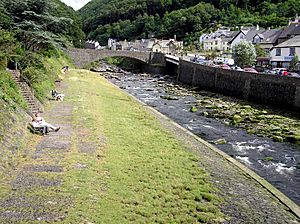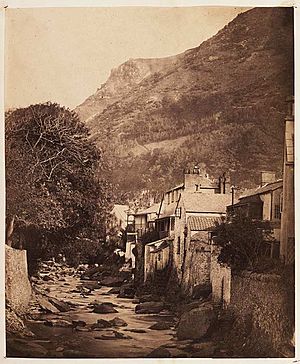Lynmouth facts for kids
Quick facts for kids Lynmouth |
|
|---|---|
 Lynmouth village |
|
| OS grid reference | SS7249 |
| Civil parish |
|
| District |
|
| Shire county | |
| Region | |
| Country | England |
| Sovereign state | United Kingdom |
| Postcode district | EX |
| Police | Devon and Cornwall |
| Fire | Devon and Somerset |
| Ambulance | South Western |
| EU Parliament | South West England |

Lynmouth is a small village in Devon, England. It sits right on the northern edge of Exmoor National Park. The village is unique because it's where two rivers, the West Lyn and East Lyn, meet.
Lynmouth is located in a deep gorge, about 700 feet (210 m) below the nearby town of Lynton. These two places are connected by the amazing Lynton and Lynmouth Cliff Railway. This railway uses water to move two cars up and down the steep slope.
The villages of Lynton and Lynmouth are part of one local council. Their area stretches south from the coast. It includes small places like Barbrook and other tiny settlements on the moor.
Many walking paths pass through Lynmouth. These include the South West Coast Path and the Tarka Trail. The Two Moors Way ends here, starting far away in South Devon. The Coleridge Way also finishes in Lynmouth.
The famous painter Thomas Gainsborough loved Lynmouth. He spent his honeymoon here. He called it "the most delightful place for a landscape painter."
The Sillery Sands beach is a quiet spot near the South West Coast Path. It is a popular place for ...s. The poet Percy Bysshe Shelley stayed in Lynmouth in 1812. He worked on his poems and loved the village.
Contents
The Brave Lynmouth Lifeboat Crew
A lifeboat station was set up in Lynmouth in 1869. This happened after a ship called Home crashed nearby. The first lifeboat was kept in a shed on the beach. Later, a special boathouse was built at the harbour. This boathouse was rebuilt and made bigger over the years.
The station closed in 1944. Other nearby stations had newer motor lifeboats that could help. The old boathouse was then used as a club. Sadly, it was washed away in the big flood of 1952. It has since been rebuilt and now includes a public shelter.
An Amazing Rescue Story
On a stormy night in January 1899, a large ship called Forrest Hall was in trouble. It was caught in a severe gale off Porlock Weir. The ship had lost its steering and was drifting towards danger. The alarm was raised for the Louisa, the Lynmouth lifeboat.
But the weather was too bad to launch the lifeboat from Lynmouth. Jack Crocombe, the lifeboat's coxswain (the person in charge), had a daring idea. He suggested taking the boat by road to Porlock's sheltered harbour. This was 13 miles (21 km) away around the coast.
The lifeboat and its carriage weighed about 10 tons! Moving it would be very hard. About 20 horses and 100 men began pulling the boat up the very steep Countisbury Hill. This hill has a 1 in 4 gradient. Six men went ahead with tools to widen the road. The highest point they reached was 1,423 feet (434 m) above sea level.
After crossing 15 miles (24 km) of wild Exmoor paths, they faced another challenge. They had to go down the dangerous Porlock Hill. Horses and men pulled ropes to slow the boat's descent. They even had to break down a garden wall and cut down a large tree to make a path!
The lifeboat finally reached Porlock Weir at 6:30 am. It was launched into the sea. Even though they were cold, wet, hungry, and tired, the crew rowed for over an hour. They reached the struggling Forrest Hall and rescued all thirteen crew members and five apprentices. Everyone was saved! Sadly, four of the horses died from exhaustion.
This incredible rescue was written about in a children's book. It's called The Overland Launch by C Walter Hodges. 100 years later, the journey was re-enacted during the day on much better roads.
The Great Lynmouth Flood of 1952
On August 15 and 16, 1952, a huge storm hit South West England. It rained an incredible 229 millimetres (9.0 in) in just 24 hours. The ground on Exmoor was already very wet. This heavy rain caused a terrible flood in Lynmouth.
Water and debris rushed down the hills towards the village. In the West Lyn valley, a natural dam formed from fallen trees and other rubbish. When this dam broke, a giant wave of water and debris crashed down the river. The River Lyn, which flowed through the town, had been covered over to make space for buildings. This covered section quickly filled with flood debris. The river then flowed right through the town, carrying huge boulders and trees.
Aftermath of the Flood
Overnight, more than 100 buildings were destroyed or badly damaged. 28 out of 31 bridges were washed away. 38 cars were swept out to sea. In total, 34 people lost their lives. Another 420 people lost their homes.
Similar floods had happened in Lynmouth in 1607 and 1796. After the 1952 disaster, the village was rebuilt. The river was even moved to flow around the village instead of through it.
A small group of houses called Middleham, located between Lynmouth and Watersmeet, was completely destroyed. They were never rebuilt. Today, a peaceful memorial garden stands where they once were.
A special memorial hall for the flood is near the harbour. It has photos, old newspaper stories, and a model of the village. This model shows how Lynmouth looked before the flood. You can also find more photos and information in St John the Baptist parish church.
Twinning
The towns of Lynton and Lynmouth are twinned with Bénouville in France. This means they have a special friendship connection.
Transport
Lynmouth has bus services that connect it to other towns. The 309/310 bus goes between Lynton & Lynmouth and Barnstaple.
Sport
The Lynton & Lynmouth Cricket Club was started in August 1876. They play their games at the beautiful Valley of the Rocks.
|






